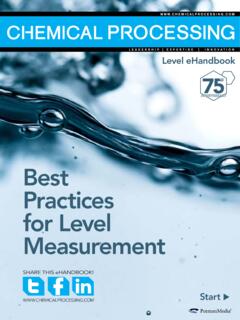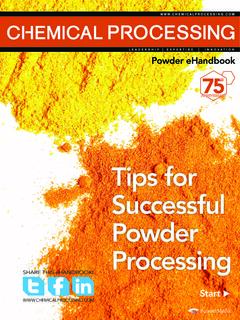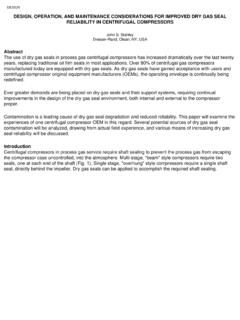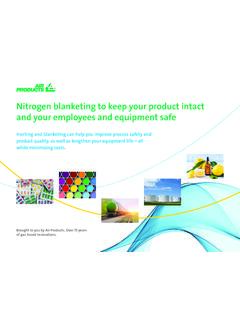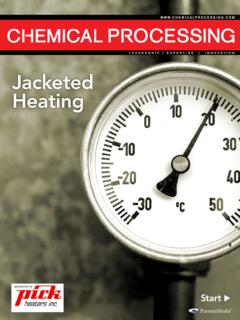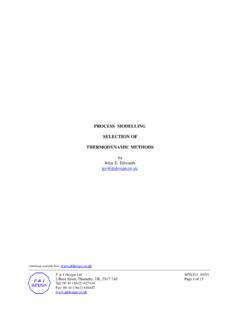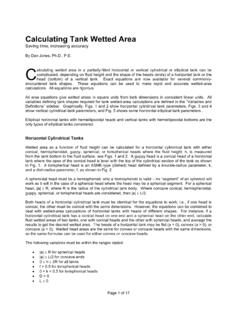Transcription of How to Make Sure Your Dust Collection System Complies with ...
1 How to Make Sure Your Dust Collection System Complies with Combustible Dust StandardsWHITE PAPERC ombustible dust explosions are a risk in many areas of a plant, but one of the most common locations is the dust Collection System . How do you know if your dust Collection System Complies ? What do you do if it doesn t? Are your employees at risk?By Tony Supine, Plant Manager, Camfil Farr APCand Mike Walters, Senior Engineer, Camfil Farr APCThis white paper reviews the OSHA National Emphasis Program for combustible dust, the NFPA standards that address how to prevent or limit explosion hazards, how to identify these hazards, and the types of equipment used for explosion protection.
2 It will also examine the most common shortfalls to compliance and how to avoid Paper: How to Make Sure Your Dust Collection System Complies with Combustible Dust Standards2 How to Make Sure Your Dust Collection System Complies with Combustible Dust StandardsBy Tony Supine, Plant Manager, Camfil Farr APCand Mike Walters, Senior Engineer, Camfil Farr APCC ombustible dust explosions are a risk in many areas of a plant, but one of the most common locations is the dust Collection System . How do you know if your dust Collection System Complies ? What do you do if it doesn t? Are your employees at risk?
3 What are the hazards and how do you identify them? The National Fire Protection Association (NFPA) sets standards and codes to protect buildings against fire and explosion risks, and the Occupational Safety & Health Administration (OSHA) is enforcing these standards with increasing vigilance. When it comes to combustible dust, several standards must be considered. This white paper reviews the current status of the OSHA National Emphasis Program for combustible dust, the NFPA standards that address how to prevent or limit explosion hazards, how to identify these hazards, and the types of equipment used to eliminate or control explosion hazards.
4 We will also examine the most common shortfalls to compliance and how to avoid last decade: a look backIn January 2003, an explosion at the West Pharmaceutical facility in Kings-ton, North Carolina killed six workers and injured 38 others, including two firefighters. The culprit: inadequate control of dust hazards at the plant. Only a month later, in February 2003, another explosion and fire damaged the CTA Acoustics manufacturing plant in Corbin, Kentucky, fatally injuring seven workers. Investigators found that resin dust, accumulated in a produc-tion area, was likely ignited by flames from a malfunctioning oven, triggering the most famous combustible dust explosion in the past decade and the one responsible for re-focusing the national spotlight on this issue was the February 2008 accident at the Imperial Sugar Company s Wentworth, These dust collectors are equipped with passive and active controls.
5 Passive controls are an explosion vent and ducting that control the pressure and flame direction, and a rotary valve that contains the flame in the hopper. The active control is a chemical isolation System mounted on the inlet duct. Triggered by a pressure/flame detector, it will extinguish a flame front passing through the inlet pipe before it goes back into the Paper: How to Make Sure Your Dust Collection System Complies with Combustible Dust Standards3 Georgia refinery. A dust cloud explosion triggered a fatal blast and fire that killed 13 workers and injured 42 others, generating a storm of media attention and government are by no means the only fatal explosions to occur in manufacturing plants, though they are the three deadliest to be investigated.
6 More recently, in December 2010, two brothers lost their lives in a chemical explosion at the New Cumberland, West Virginia plant of AL Solutions. And during 2011, three deadly fires and explosions occurred at a Hoeganaes Corp. plant in Gallatin, Tennessee. Investigators found that accumulations of fine iron powder in the facility led to the explosions. In the alone in the 25 years between 1980 and 2005, the Chemical Safety Board reported 281 explosions caused by ignited combustible dust. These explosions resulted in 199 fatalities and 718 injuries. Combustible dust explosions over the past decade in plants are blamed for well over 100 fatalities and hundreds more injuries.
7 Sadly, experts believe these accidents could have been prevent-ed if the companies involved had followed best practices for fire and explosion protection such as the methodologies described in this white paper. Agencies involvedThere are three key entities involved in combustible dust issues, each with its own particular area of responsibility:NFPA: The NFPA sets safety standards, amending and updating them on a regular basis. As noted, when it comes to combustible dust, there are several different documents that come into play, as summarized in the section directly below. Togeth-er these standards add up to total protection to prevent an explosion, vent it safely, and/or ensure that it will not travel back inside a building.
8 Most insurance agencies and local fire codes state that NFPA standards shall be followed as code. Exceptions would be where the authority hav-ing jurisdiction (AHJ), such as Factory Mutual, specifies an alternative safe-ty approach which might be even more stringent. OSHA: It is OSHA s role, together with local authorities, to enforce the standards published by NFPA. In This dust collector is equipped with an explosion vent with vertical upblast deflector plate. Other safety features include a sprinkler System and filters with special carbon-impregnated media for static dissipation. White Paper: How to Make Sure Your Dust Collection System Complies with Combustible Dust Standards4the aftermath of the Imperial Sugar Company explosion in 2008, OSHA re-issued its 2007 Combustible Dust National Emphasis Program (NEP) outlining policies and procedures for inspecting workplaces that create or handle combustible dusts.
9 As defined by OSHA, These dusts include, but are not limited to: metal dust such as aluminum and magnesium; wood dust; coal and other carbon dusts; plastic dust and additives; bio-solids; other organic dust such as sugar, flour, paper, soap, and dried blood; and certain textile materials. The revised NEP, which OSHA reissued on March 11, 2008, was designed to ramp up inspections, focusing in particular on 64 industries with more frequent and serious dust incidents. According to an October 2011 OSHA update on its Combustible Dust NEP, since the commencement of inspections under the 2008 program, more than 2,600 inspections have occurred.
10 More than 12,000 violations were found during this timeframe, including more than 8,500 which are classified as serious. Federal penalties and fines for these violations have totaled $22,738,909, with nearly another $1,600,000 in state fines. OSHA uncovered a variety of dust Collection violations in these inspections, including dust collectors that were not equipped with proper explosion protection devices and systems that were not vented to safe locations. (Figure 1) Chemical Safety Board (CSB): The CSB is an independent federal agency responsible for investigating industrial chemical accidents. Staff members include chemical and mechanical engineers, safety experts, and other specialists with chemical industry and/or investigative experience.
